| 1 | Familiar to everyone in Bangkok |
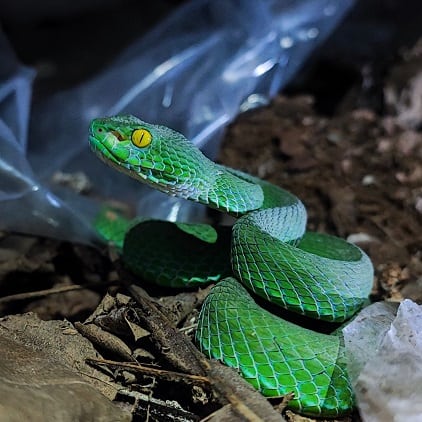
Some pitvipers lurk only in misty mountains, guarded by thick rainforests containing a thousand other dangerous creatures. The large-eyed pitviper is the opposite: it’s well accustomed to human interference and even lives in bustling towns. This is a dangerously venomous snake which lives in most of Thailand, excluding the south. It’s often found side by side with the white-lipped pitviper, its cousin in the Trimeresurus family.
More than any other, these two pitvipers have seized control of Bangkok, lurking in its leafy parks, household gardens, and bushes behind bus stops. These are the only two green pitvipers found in Bangkok, and while they’re easily confused, everyone knows to avoid them. Large-eyed pitvipers (Trimeresurus macrops) have learnt to coexist with humanity and vice versa. People hurry past them in alleyways every day, trying their best to keep walking.
Thailand is full of venomous snakes. There’s king cobras, monocled cobras, and blue coral snakes. But statistics reveal that the large-eyed pitviper, together with the white-lipped pitviper, cause 95% of all snakebites in Bangkok. Furthermore, bites have risen by an estimated 76% since 1977.
| 2 | Huge eyes and other ID signs |
Walking the streets of Bangkok, it’s extremely difficult to tell one green pitviper from another. The large-eyed and white-lipped are both leafy green with a snowy white line below the mouth, which extends down their entire body as a dividing line between the belly. Both have subtle blue patches, both have black lines between their green scales, and both have yellow-orange eyes.
The orb-like eyes are the obvious difference, but this becomes most noticeable in adulthood. As juveniles, the majority of snakes have disproportionately larger heads and eyes. A white-lipped pitviper’s eyes become more normal with age, but with Trimeresurus macrops, they stay bulging forever.
There’s a second easy difference as well: large-eyed pitvipers have a more triangular head. It’s already pretty triangular in the white-lipped pitviper, but in Trimeresurus macrops, the head widens particularly far behind the eyes, creating the bulky cheeks (see this and this image for a great comparison). Elsewhere, scientists use subtle scale differences, such as a wider supraocular scale (the scale directly above each eye) in the large-eyed pitviper. This species is also smaller than the white-lipped pitviper: a maximum of 74cm versus 104cm.
| 3 | Relatively mild venom |
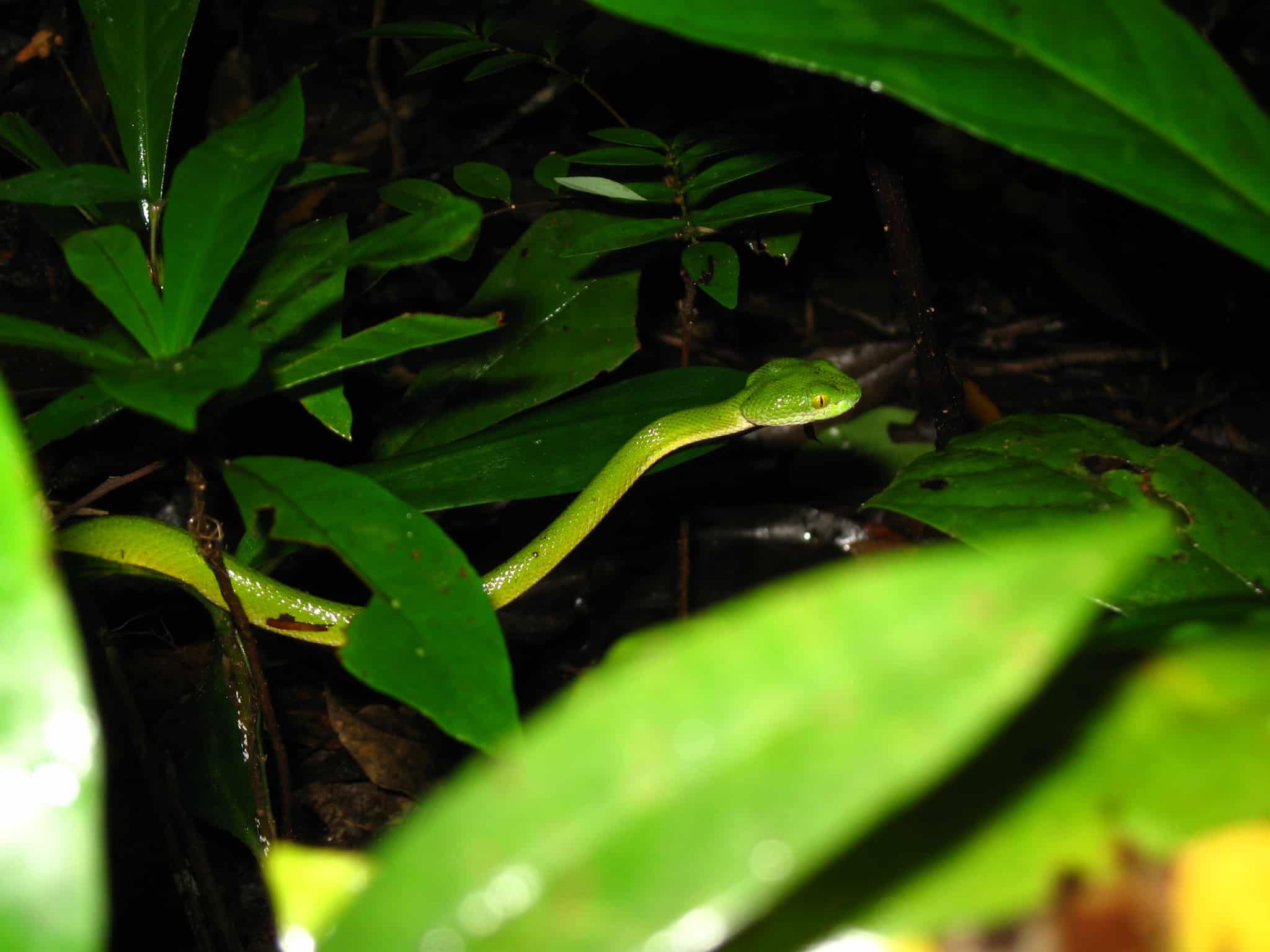
Large-eyed pitvipers spend most of their day resting on bushes and low branches, commonly at a human being’s eye level. They’re nocturnal, and are most likely to strike in complete darkness. This snake weighs just 36-108 grams, and its bite is unlikely to kill, but can result in a serious hospital stay.
According to this study on 29 patients, Trimeresurus macrops has a milder bite than its white-lipped pitviper neighbour. Its bites mainly caused swelling, and thrombocytopenia, a severe fall in the platelets which stick together to seal wounds. It also caused leucocytosis, an unhealthy surge in immune system neutrophils. Meanwhile, white-lipped pitvipers caused necrosis, spontaneous bleeding, shock and painful blistering.
However, large-eyed pitvipers can also cause those severe symptoms, just not as commonly. Severe haemorrhaging across the body has been reported from Thai hospitals. The most worrying thing about large-eyed pitviper venom is its half life, as it remains in the bloodstream for 14 days. There’s no antivenom specific to the large-eyed pitviper, but white-lipped pitviper antivenom has a high effectiveness.
| 4 | No neurotoxins, but plenty of swelling |
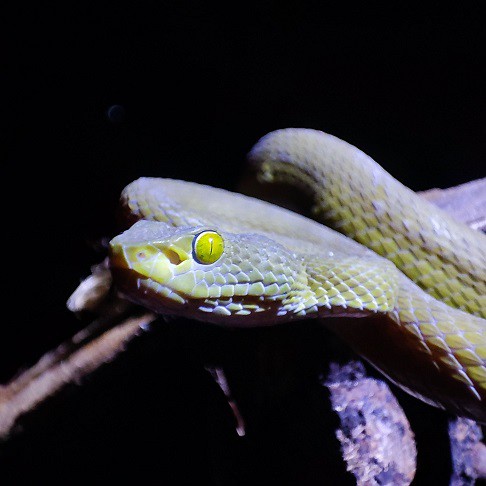
Large-eyed pitvipers have virtually no neurotoxic qualities, such as paralysis, laboured breathing or twitching muscles. Instead, they specialise in swelling and haemorrhaging. A 2020 study discovered 185 proteins in its venom, with toxins including…
Serine proteases (11 proteins) – these cleave through fibrin, the backbone of human blood clotting, thus causing haemorrhaging and gushing blood from the bite wound.
Metalloproteinases (13 proteins) – attacks fibrin, but also causes haemorrhaging by assaulting local skin cells and the walls of capillaries.
Disintegrins (9) – contribute to haemorrhaging by inhabiting platelet aggression and cell adhesion.
L-amino oxidase (2) – these oxidise the amino acids of protein structures, and cause apoptosis in various cells.
Many of the proteins still remain mysterious. The same study tested Trimeresurus macrops venom in human skin fibroblasts in a petri dish. It was compared to Hagen’s pitviper, a species found in southern Thailand and along the Malaysian border. Trimeresurus macrops venom caused severe damage to human fibroblasts, while Hagen’s pitviper caused just mild damage. As they’re milder than the white-lipped pitviper, large-eyed pitvipers probably rank in the middle of the Trimeresurus family for deadliness.
| 5 | Barely moves all day |
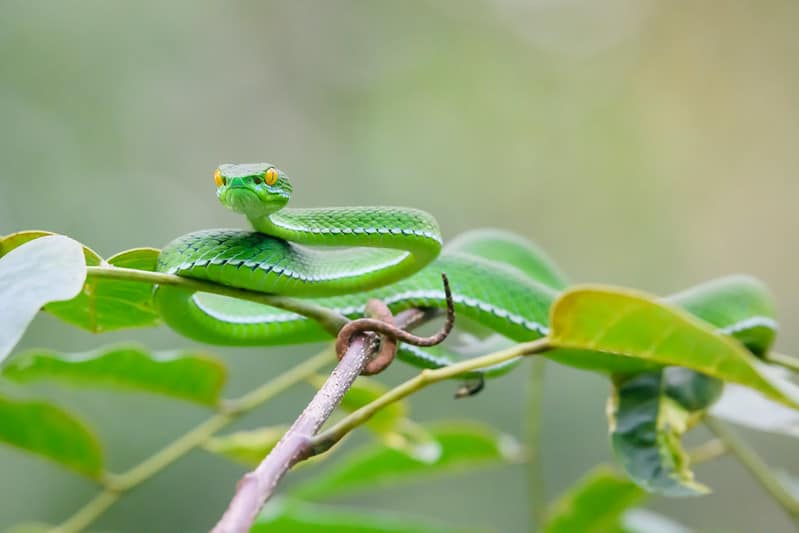
In 2018, our knowledge about the large-eyed pitviper increased dramatically. We already had local tales and confrontations, but that year, a team of scientists headed to Sakaerat Biosphere Reserve in Thailand, a vast nature reserve 300km north of Bangkok. 17,000 school children visit the reserve each year, and aside from the occasional research station, whole civilisations of birds and snakes are left completely to themselves.
The scientists tracked 13 adult females, for an average of 73.6 days. They monitored how they led their lives in an untouched Thai landscape, with minimal human interference. Their first finding was that Trimeresurus macrops is an exceptionally lazy snake. The 13 snakes moved an average of just 3.2 metres daily in the forest, and 4.1 metres near the research station. One pitviper went 21 days without moving, making only minimal body readjustments.
Sometimes, the snakes would relocate themselves to find a superior ambush site. Even these were nothing – most moves were within 13.3 metres and 43.4% were within 5 metres. There were a handful of exceptions, as one female went mad and travelled 141.4 metres in a single night. Trimeresurus macrops has the capability of being energetic, but simply can’t be bothered. On average, the large-eyed pitvipers performed these relocations once every 4.6 days.
| 6 | Narrow temperature range |
The study also found that at above 31.2C, the large-eyed pitvipers stopped moving completely. Likewise, when the mercury fell below 23.2C, they completely shut down. The scientists didn’t once observe movement outside of this 8 degree temperature range. The lowest temperatures the scientists recorded in the Sakaerat Biosphere Reserve was 12.8C, while on the upper end they reached 39.4C. In Bangkok, the amount of bites also has a positive correlation with rainfall.
It’s common knowledge that large-eyed pitvipers are nocturnal, as any Bangkok citizen discovers through a pair of gleaming yellow eyes in torchlight. This study confirmed their heavily nocturnal ways. Their general pattern was ambushing at night, and resting during the day. Only once was Trimeresurus macrops spotted ambushing during the day, an extreme fluke.
When resting, large eyed pitvipers lie on a branch coiled up, with their head resting motionless on their coils or a branch. When ambushing, they keep their head raised in the air, ready to strike, with their lower body coiled.
| 7 | They’re loners |
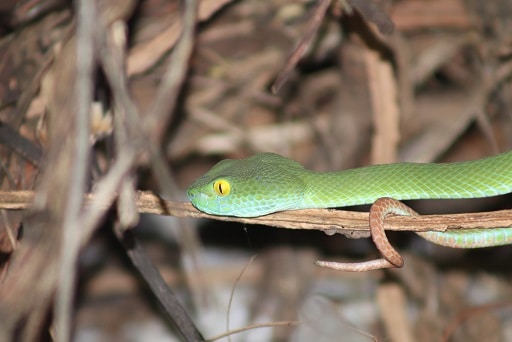
After nearly 2.5 months camped in the wild biosphere reserve, scientist made more discoveries about the large-eyed pitviper than ever before. Yet another was that they had a tiny home range. Because they moved just 3-4 metres daily, their home range was calculated at 0.175 hectares.
This was far below even other lazy pitvipers around the world. For example, a timber rattlesnake’s home range was calculated at 27.4 hectares, a common lancehead’s at 5.95 hectares, and a prairie rattlesnake’s at 8.0 hectares. Large-eyed pitvipers have a narrow slice of land, but that said, they rule over it completely. It was rare for fellow Trimeresurus macrops to stray into each other’s turf. Even when the tracked females approached to within 5 metres, they completely ignored each other. This species has no social instincts, unlike the Arizona black rattlesnake, which gathers together in dozens in rock cracks.
Of the 13 adult females, the longest tracked measured 74.1cm. This defeated the previous record, which was a 72.0cm snake mentioned in this 2015 study. The second longest was 73.8cm, and the shortest measured 53.8cm.
| 8 | Prefers relatively low branches |
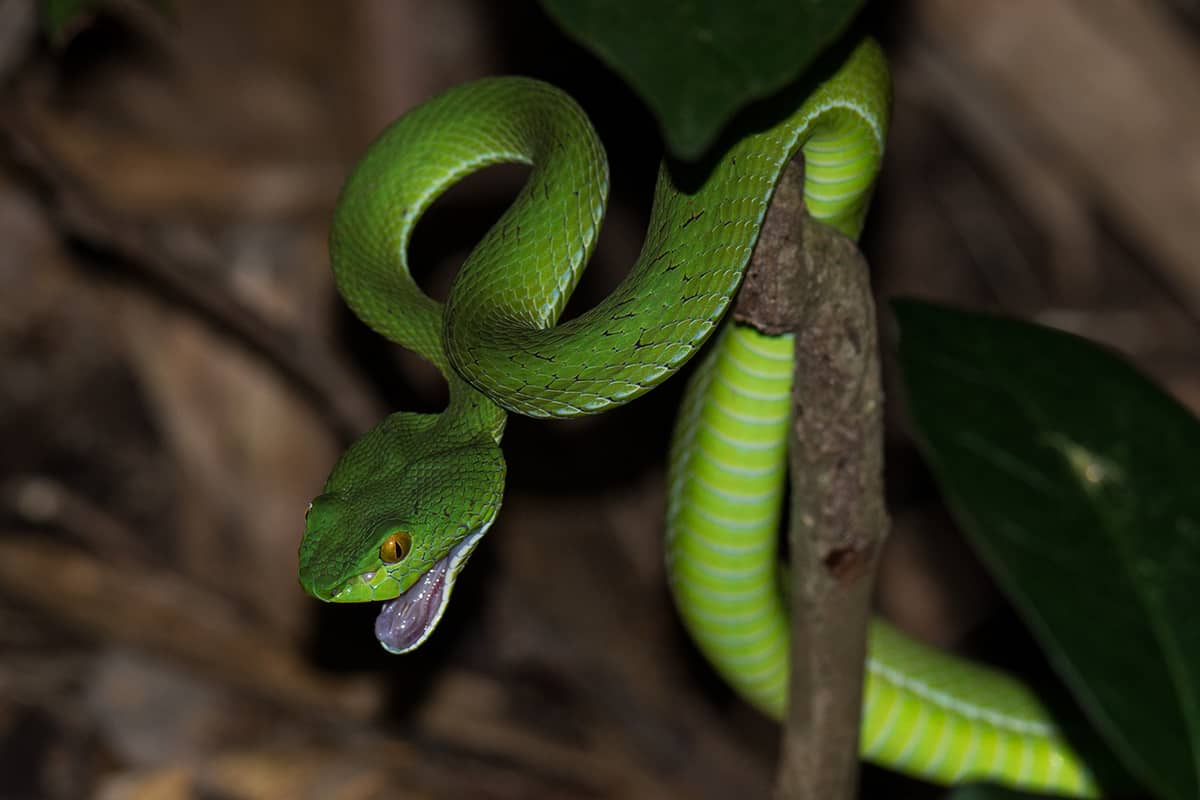
Everyone in Bangkok knows that this is a snake of low bushes and branches at eye level. This study finally provided the technical breakdown everyone’s being hoping for. Over 13 females studied for 73 days, it found that their favourite spot was in groundstory, vegetation 0-1 metres above ground, in which they spent 48.8% of their time. Second favourite was understory (22.5%), branches 1-3 metres above ground. Then came ground (13.8%), followed by midstory (11.5%), 3-10 metres above ground.
They also spent 3.8% of their time underground. Trimeresurus macrops takes shelter in burrows occasionally, though nowhere near as often as a blue krait. All these underground sightings took place during the day, during times of rest. The large-eyed pitvipers also hid in hollow logs and rock cracks during the day. Near the research station, they hid under concrete porches and below metal doors.
Large-eyed pitvipers aren’t completely stuck on branches. Their ambush sites also included thick brush patches and twisting root complexes, from which they spring at unsuspecting prey. Large-eyed pitvipers preferred low branch perches (0-1 metres) while ambushing at night, compared to day when they retreated to higher (understory: 1-3 metres) for safety.
| 9 | Their closest relatives |
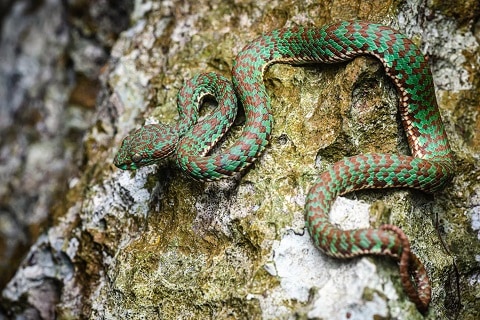
With 44 members, the Trimeresurus pitviper viper is huge, and there’s many sub families within. Appearances deceive, as the white-lipped pitviper they coexist with in Bangkok belongs to a more distant branch in the family.
The closest relative of the large-eyed pitviper is the Kuri Buri pitviper, discovered in 2021, a rare species found only in Prachuap Khiri Khan province. Its second closest relative is the beautiful pitviper (Trimeresurus venustus), found across a swathe of south central Thailand. Another two close relatives are…
Ruby-eyed pitviper – discovered in 2012. Has red eyes and found in the forests of Vietnam, including near Ho Chi Minh City.
Cambodia pitviper – became an official species in 2011 and lives in the Cardamom mountains of Cambodia’s southwest.
These two species originally belonged to the large-eyed pitviper, and consequently, its territory shrank when they were broken off. With the revised map, the situation is that Trimeresurus macrops resides in southern Laos, northwest Cambodia, and most of Thailand, excluding the southern peninsula.
| 10 | Nemesis: king cobra |
Large-eyed pitvipers are powerful, but have a mortal enemy in the wild. This 2015 study followed 139 large-eyed pitvipers around the Sakaerat Biosphere Reserve, researching male-female differences. Sadly, the survey went horribly wrong when two of them were swallowed by a king cobra. This added another confirmed meal to the king cobra’s diet: previous entrants included oriental ratsnakes, sunbeam snakes and small reticulated pythons. Venom doesn’t stop them.
The study itself discovered that female large-eyed pitvipers are longer than males, as well as thicker. Females averaged at 61.64cm versus 58.93cm in males. However, males had longer tails, which may allow them to climb higher, combined with their lighter weight.
While not as extreme as the Wagler’s pitviper, females looked subtly different. Males kept their snowy white stripe into adulthood, while females lost it after year 1. Not a single adult female was seen with a white stripe. The same is true for the white-lipped pitviper, meaning that in Bangkok, this is the ultimate gender determiner for green pitvipers. Meanwhile, both genders can have electric blue patches on their chin.
